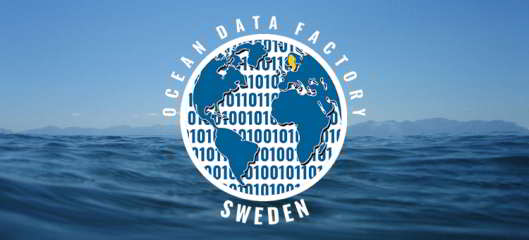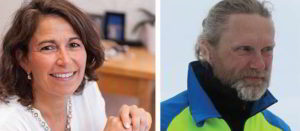
Visits: 25
– The sea covers more than 70% of the Earth’s surface, and humans have only explored 5% of it. In their recently launched Ocean Data Factory project Robin Teigland of Chalmers University of Technology and Torsten Linders of the University of Gothenburg are starting Sweden’s first marine database, focusing on innovation.
Courtesy Chalmers University by Hiba Fawaz : The world beneath the ocean surface has yet to have been properly explored. This is something Chalmers professor Robin Teigland wants to change in connection with the Ocean Data Factory project. What first started as an idea to create Sweden’s first marine research database has now been developed into a data factory to support and develop innovation in the marine environment.
“We don’t just want access to sea data; we also want to provide an opportunity to convert it into innovation.” Robin Teigland, Chalmers
In a conversation with Torsten Linders of the University of Gothenburg, Robin Teigland talked about the importance of marine innovation – and the major challenges of accessing the data required for innovation to grow.
“The sea is the next big thing – the Blue Economy. This is a growing economic area, and there is too little understanding in Sweden of the options available out there. This is true both of research and of the projects the government, for example, decides to fund,” says Robin.
Several types of marine databases have been created, mainly in countries bordering the sea, such as the US, Norway, and Canada – but not Sweden. A reason that initially drove Torsten and Robin to launch this project.
“We want to encourage the development of tools that help transform data into innovation. So, this isn’t just a database or a portal where you can find information, like in other countries. It’s a factory where you can transform data into innovation,” says Robin.
She underlines the irony of us knowing more about Mars than about the seas and oceans on Earth. However, she sees great potential in the fact that marine development and innovation have begun to enter our daily lives more and more. And that it is essential today to consider the critical condition of the sea. She also believes there are many potential applications. For example, the ocean could be a major resource for energy, food production, and marine development.
“We don’t know what’s out there. What species there are, how they interact with each other, how they affect humans or how they are affected by climate change. Imagine if there’s a cure for cancer or a major energy source down there? There is great potential.”
“Marine data is increasingly benefiting in various sectors, such as transport, aquaculture, healthcare, and energy. How can we contribute to sustainable marine development?”
“We know very little about the sea. We know more about Mars than about the sea.” Robin Teigland, Chalmers
Via the database, they hope to gain access to various types of data. Primarily data on the health of the sea. Before we know what we need to measure, Robin says that we first need to know what problem needs to be solved.
“Monitoring the health of the sea is an extremely interesting field. That’s why we’ve made it our first user case in which we’ll investigate what we need to measure to obtain the data. pH value, temperature, level? First, we need to establish the problem. This is why we’ll be working with partners such as the Swedish Agency for Marine and Water Management.”

From open data to innovation factory
It started with a workshop on open data from the sea. Planning immediately began to create a joint platform for sharing expertise. Torsten explains that he and Robert Rylander (RISE) had already made some progress on planning the project and had built on previous and ongoing projects in the field of marine innovation. When he met Robin at a workshop, he saw the opportunity for collaboration.
“I realised that she would give the project an additional boost. Robin enhances our profile in innovation and digitalization and has consistently been involved with sustainability, particularly in marine networks,” says Torsten Linders.
Both Robin and Torsten stress that there are various portals worldwide that can contribute to marine data. However, Torsten believes the biggest challenge is the lack of expertise on how to use the data. The more research uses data that already exists, the more it becomes clear what is missing.
“Enhanced, innovative use of existing data will contribute to the collection of more data. And if we can increase the use of data that already exists, we can justify the collection of new data,” says Torsten.
Robin also emphasises that much of the project is about cross-border collaboration and says that it will allow Sweden to take the lead in terms of marine innovation.
“If you are based in Sweden as a researcher, you’re mainly looking for access to a Swedish portal that can help you move forward. International portals don’t offer Swedish data from sources such as SMHI or the Swedish Agency for Marine and Water Management. This data is local and unique here, and it is important for Swedish innovation.”
A future of blue innovation
According to Torsten Linders, the principal goal of the data factory is to generate learning about the use of marine data.
“Sustainable management of the marine environment requires knowledge at a level that we currently lack. And what limits us is access to actual measurements from the sea. More resources are not enough. Only innovation can achieve this.”
“We have achieved so much on land, but the sea is the unexplored frontier” Robin Teigland, Chalmers
Robin Teigland is excited about all the innovations she hopes the project will generate. She also hopes that it will put not only Chalmers but Sweden on the marine innovation map. At the same time, she wants development to take place more sustainably.
“Sustainability is incredibly important to me. It is essential to all aspects of the project. We have achieved so much on land, but the sea is the unexplored frontier. We have only just been able to start exploring it. We lacked the tools, the connection or even the interest previously – now that these are in place, we have infinite possibilities.”
FACTS
Collecting and securing data
To ensure as wide a range of data collection as possible, the plan is to use three different data sources. Firstly, open sources such as data from environmental monitoring and data from satellites via bodies such as SMHI (the Swedish Meteorological and Hydrological Institute). Secondly, the project’s partners. Chalmers and GU have decided to work with various bodies such as RISE (Research Institutes of Sweden), the Swedish Agency for Marine and Water Management, SND (the Swedish National Data Service) and many more.
The last data source will be the data created during the project. This data will be generated partly by processing existing data for AI solutions and, to some extent, from the project’s measurements. Robin Teigland hopes to work with a company that has developed smart surfboards that measure marine data while you surf. This would offer the opportunity to create a tool that analyses the volume of microplastics in a certain area of the sea. Today, the tests have to be conducted on land, which means we don’t know how they would be affected. Robin stresses how important data would be in such a situation, and to make it possible to create such a tool.
Read more about the project
Ocean Data Factory Sweden is managed by professor Robin Teigland from Chalmers University of Technology. The project coordinator is Torsten Linders at Gothenburg University.
The project started in July 2019 and is planned to be an arena for building expertise and for innovation in the marine environment.
ODF Sweden is part of Vinnova’s investment in data labs to accelerate AI developments.
For more information about the project and participating partners, go to www.oceandatafactory.se or https://scootech.se/odf/
Related article: Breaching a “carbon threshold” could lead to mass extinction